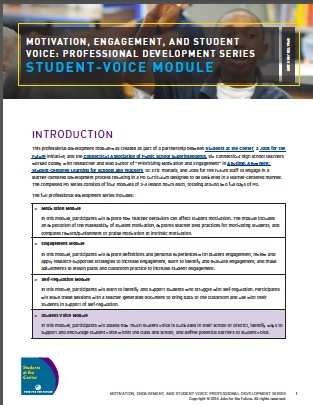 This professional development module was created as part of a partnership between Students at the Center, a Jobs for the Future initiative, and the Connecticut Association of Public School Superintendents. Six Connecticut high school teachers worked closely with researcher and lead author of “Prioritizing Motivation and Engagement” in Anytime, Anywhere: Student-Centered Learning for Schools and Teachers, Dr. Eric Toshalis, and Jobs for the Future staff to engage in a learner-centered development process resulting in a PD curriculum designed to be delivered in a learner-centered manner. The completed PD series consists of four modules of 3-4 lesson hours each, totaling around two full days of PD.
This professional development module was created as part of a partnership between Students at the Center, a Jobs for the Future initiative, and the Connecticut Association of Public School Superintendents. Six Connecticut high school teachers worked closely with researcher and lead author of “Prioritizing Motivation and Engagement” in Anytime, Anywhere: Student-Centered Learning for Schools and Teachers, Dr. Eric Toshalis, and Jobs for the Future staff to engage in a learner-centered development process resulting in a PD curriculum designed to be delivered in a learner-centered manner. The completed PD series consists of four modules of 3-4 lesson hours each, totaling around two full days of PD.
Jobs for the Future is currently working to test the Motivation, Engagement, and Student Voice Professional Development Series with educators across the country. We will continue to iterate the modules throughout this process. We welcome all comments and feedback as you explore and implement the lessons in this series.
In the Student Voice module, participants will assess how much student voice is cultivated in their school or district, identify ways to support and encourage student voice within the class and school, and define potential barriers to student voice.
Lesson 1
Learning Outcomes:
At the end of this unit, participants will be able to:
- Reflect on the power of “having voice”.
- Define student voice activities along a spectrum of increasing ownership.
- Brainstorm activities that fall across a broad spectrum of student voice.
Essential Questions
- What is student voice?
Total time
60 minutes
Lesson 2
Learning Outcomes:
In this unit, participants will:
- Deepen their understanding of the spectrum of student voice.
- Connect student voice to student motivation.
- Select their personal focus for the inclusion of student voice in the teaching and learning process.
Essential Questions
- What does student voice look like in action?
- Why is “voice” so motivating for youth?
- On which parts of the student voice spectrum do I tend to focus?
Total time
70 minutes
Lesson 3
Learning Outcomes:
In this unit, participants will:
- Identify various supports to encourage student voice at the classroom and the school level.
- Identify potential obstacles to student voice, and think through supports for these barriers.
Essential Questions
- What structures and systems support student voice?
- What common barriers exist?
Total time
75 minutes
Lesson 4
Learning Outcomes:
In this unit, participants will:
- Identify various supports to encourage and support student voice at the classroom and the school level.
- Analyze several student voice projects carried out at other sites and look for insights into how such projects might be implemented at one’s own school.
Essential Questions
- What structures and systems are needed to support forms of instruction that are rich with student voice components?
Total time
60 minutes
Lesson 5
Learning Outcomes:
In this unit, participants will:
- Identify various ways and supports to encourage and support student voice within the class and school.
- Enrich a current lesson with elements that support student voice.
Essential Questions
- How can I increase student voice in an assignment or project?
- What structures support student voice at a school-wide level?
- What strategies can we use in the classroom to cultivate student voice?
Total time
65-85 minutes
The full professional development series also includes:
Motivation Module
In this module, participants will explore how teacher behaviors can affect student motivation. The module includes an exploration of the malleability of student motivation, explores teacher best practices for motivating students, and compares reward/punishment or praise motivation to intrinsic motivation.
Engagement Module
In this module, participants will explore definitions and personal experiences with student engagement, review and apply research-supported strategies to increase engagement, learn to identify and evaluate engagement, and make adjustments to lesson plans and classroom practice to increase student engagement.
Self-Regulation Module
In this module, participants will learn to identify and support students who struggle with self-regulation. Participants will leave these sessions with a teacher-generated document to bring back to the classroom and use with their students in support of self-regulation.
Download the full Student Voice Professional Development Module